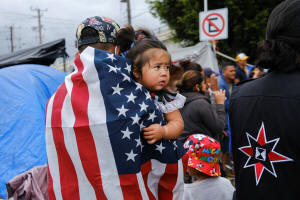How confusion around Biden policies birthed a new refugee camp on the
U.S. border
 Send a link to a friend
Send a link to a friend
 [May 07, 2021]
By Mimi Dwyer and Lizbeth Diaz [May 07, 2021]
By Mimi Dwyer and Lizbeth Diaz
TIJUANA, Mexico (Reuters) - A red pickup
truck pulls up next to a migrant tent encampment in the Mexican city of
Tijuana, its bed filled with loaves of bread and clothes. Men, women and
children run to meet it.
"A line! Form a line!" someone yells. A woman in a long skirt climbs
into the truckbed and begins to preach into a microphone: "You all are
hoping to cross into the United States!" she says. "You all are hoping
to be blessed! Well, take God's hand!"
Migrants raise their hands in prayer. Food can be scarce in the
encampment, and the line stretches back down the road, past dozens of
tents and dirty portable restrooms.
Right up against the popular pedestrian crossing from Mexico to the
United States at El Chaparral, a refugee camp has mushroomed in recent
months, filled with asylum seekers desperate to cross the still-closed
U.S.-Mexico border.
Migrant activists say the camp, which started growing in February and
now numbers some 2,000 migrants by one count, sprang up in part as an
unintended consequence of U.S. President Joe Biden's mixed approach to
undoing the hardline immigration policies of his predecessor, Donald
Trump.

The camp is growing increasingly dangerous, migrants and activists told
Reuters, with unsanitary conditions, drug use, and gangs entering the
area. Governmental organizations are largely absent, and humanitarian
presence is only intermittent. Rumors fuel hope among migrants that they
will soon be able to enter the United States.
Reuters spent four days speaking with more than two dozen migrants in
the camp, which consists of tents and tarps sprawled out in different
directions in a concrete plaza and under an overpass.
Hundreds of children, including infants, live in the camp. Most of the
migrants are Mexican and Central American.
Talk of kidnapping attempts is rampant, and many migrants avoid leaving
their tents for fear of their safety and the safety of their children.
The only consistent state security are Tijuana municipal police cars
parked at the camp's edge. But migrants say that is not enough to make
them feel safe.
"I don't sleep at night," said Rosy, a migrant from the Mexican state of
Guerrero who is terrified that her three children, aged 5, 3, and 5
months, will be kidnapped.
The camp has no running water other than a diverted pipe used for
cooking and bathing. Activists say its portable toilets are cleaned too
infrequently to be hygienic. There is no governing structure within the
camp, which relies on donations from churches, nonprofits and
individuals for basic sustenance.
MIXED POLICIES
In February, the Biden administration announced it would begin phasing
out Trump's Migrant Protection Protocols (MPP) program, which had forced
thousands of asylum seekers to wait in Mexico for their asylum cases to
be heard. People with active MPP cases would be allowed into the United
States. By March, the notorious Matamoros refugee camp just across the
border from Texas - where many in the MPP program had waited for their
turn to be processed - was closed.

Activists told Reuters that the announcement directly influenced the
start of the new camp in Tijuana, opposite San Diego and some 2,500
miles (4,000 km) away from Matamoros. Migrants began to camp on Feb. 18,
the night before processing began for the MPP migrants, amid confusion
about who exactly would be admitted to the country.
The U.S. border remains closed to the vast majority of asylum seekers
under a Trump-era COVID-19 health-related order which Biden has not
revoked.
But the confusion remains. Many migrants Reuters spoke to said they had
believed they would soon be able to claim asylum in the United States
once they got to the camp, based on rumors and news items that the
situation at the border had changed under Biden, who took office in
January.
Biden is trying to balance a more humane immigration policy with a
desire not to encourage further migration from Mexico and Central
America. He is already contending with growing criticism from opposition
Republicans and even Democrats over a rise in the number of people
crossing the southern border illegally.
The White House said in a statement it would take time to rebuild the
country's immigration system after the Trump administration. It did not
address questions from Reuters about the wind-down of MPP influencing
the start of the Tijuana camp, referring further queries to the
Department of Homeland Security (DHS).
[to top of second column]
|

Honduran migrant Kevin, wearing a U.S. flag, holds his daughter
Keiry, during a multicultural activity at a makeshift camp at the El
Chaparral border port of entry with the U.S., in Tijuana, Mexico
April 22, 2021. REUTERS/Toya Sarno Jordan

"The Biden administration has made it clear that our
borders are not open, people should not make the dangerous journey,
and individuals and families are subject to border restrictions,
including expulsion," a DHS spokesperson said in a separate
statement. "Physical presence at a port of entry or an encampment"
does not provide access to the phased system for entry into the
United States, the spokesperson said.
The Mexican foreign ministry said in a statement that government
representatives had tried to encourage migrants to go to shelters.
Tijuana's director of migrant affairs, José Luis Pérez Canchola,
said officials were trying to find a safe space for the migrants,
but there was no concrete plan yet.
Migrants said they feared that if they moved away from the
encampment they might lose their place in a line that does not
really exist, or that conditions in shelters would be worse than in
the camp. Some were afraid to leave their tents for safety.
Some had lived elsewhere in Tijuana for months, while others had
arrived only recently. Others said they had crossed into Texas and
been expelled into Tijuana, and came to the camp because they did
not know where else to go.
GROWING DANGERS
New families arrive every day at the Tijuana camp, entering what
activists and camp dwellers say is an increasingly dangerous
situation, with reports of gang members walking through the camp,
selling drugs or checking for members of rival gangs.
The Matamoros encampment was widely seen as a result of Trump's
hardline policies, but some activists say that in many ways the
situation in Tijuana is even worse.

While Matamoros was dangerous and squalid, there was eventually a
strong NGO presence, and it was demarcated by barriers. Migrants
there were also on a path to potential entry to the United States.
"The migrants in the Tijuana camp are definitely worse off," said
Erika Pinheiro, legal and policy director for Al Otro Lado, a
nonprofit which initially went in person in the encampment but has
stopped, due in part to a lack of in-person volunteers and security
concerns.
"There is less infrastructure, more security concerns, and migrants
aren't connected to any functioning asylum process," she said. The
organization is serving migrants, including some from the camp,
through a remote screening process.
Dulce Garcia, executive director of Border Angels, a nonprofit that
has been working in the camp, said she regularly gets messages from
terrified camp dwellers at night. They have reported beatings and
kidnapping attempts. She no longer goes to the encampment alone, she
said, because she fears for her safety, and is hoping that more
volunteers will start working in the camp to make it safer.
"You stay quiet, but you live in fear," said Ana, a 21-year-old from
Guatemala who is desperate to enter the United States to rejoin her
father. "I was kidnapped and bad things have happened to me, and I
live with the fear that it's going to happen again."
In recent days, the migrants have begun marching to the San Ysidro
port of entry with protest signs that read things like "BIDEN
SOLUTION," "WE WANT TO BE HEARD," and "WE NEED POLITICAL ASYLUM."
There is talk in the camp of a hunger strike.
"The only thing we want is an answer from the president," said
Claudia Melendez, a Honduran asylum seeker who came to the camp a
month ago. "He hasn't said a thing."
(Reporting by Mimi Dwyer and Lizbeth Diaz, additional reporting by
Laura Gottesdiener in Monterrey, Ted Hesson in Washington, Mica
Rosenberg in New York, and Kristina Cooke in San Francisco, editing
by Ross Colvin and Rosalba O'Brien)
[© 2021 Thomson Reuters. All rights
reserved.] Copyright 2021 Reuters. All rights reserved. This material may not be published,
broadcast, rewritten or redistributed.
Thompson Reuters is solely responsible for this content.
 |